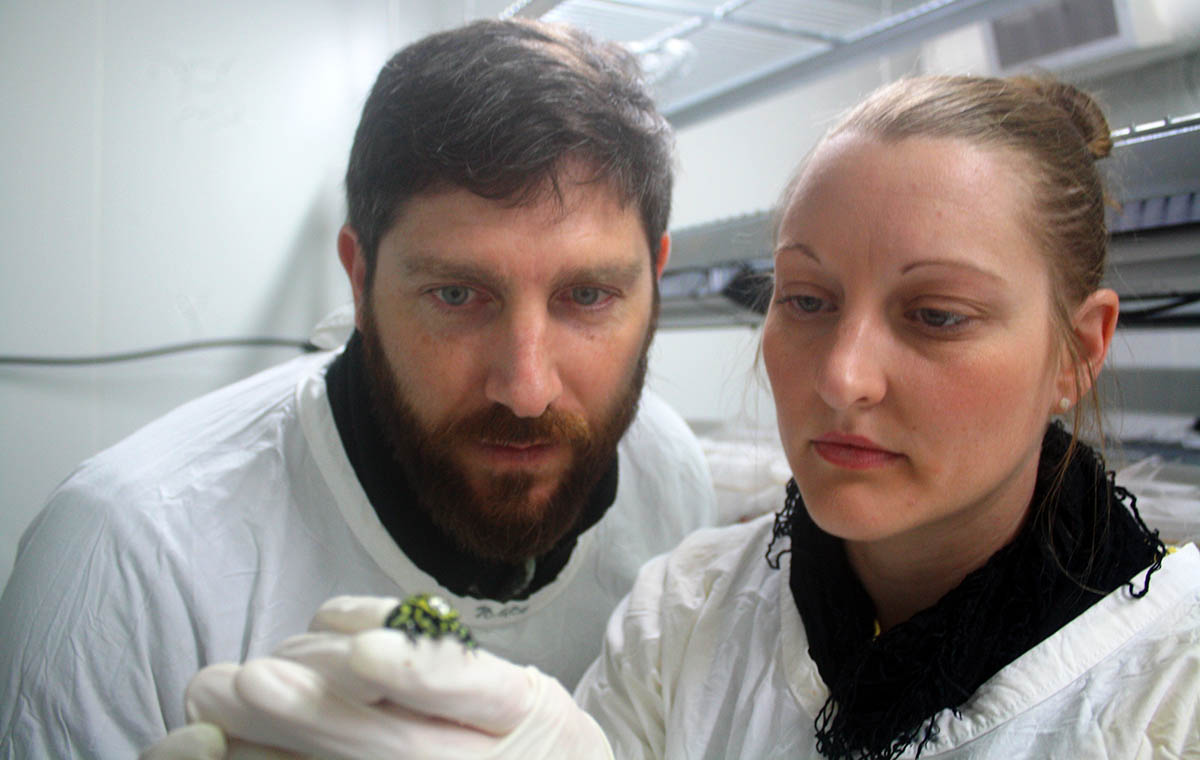December 6, 2018
Hormones help endangered frogs get in the mood to mate in world-first program
Assisted breeding technique produced hundreds of northern corroboree frog offspring
In a world first, reproductive biologists at the University of Wollongong (UOW) have successfully applied hormones topically to the abdomens of northern corroboree frogs to get breeding pairs of the critically endangered frog “in the mood” to mate.
The program has enabled the generation of hundreds of offspring, with more than 800 viable eggs produced using hormone-assisted breeding techniques over the past four years.
Northern corroboree frog offspring of different developmental stages (eggs, tadpoles and juvenile frogs) have been released into sites in the northern Brindabella Ranges, with more than 100 juvenile frogs released in recent weeks by herpetofauna experts from UOW and Taronga Zoo.
Dr Aimee Silla and Dr Phillip Byrne from UOW’s Centre for Sustainable Ecosystem Solutions led the research project, teaming up with Taronga Conservation Society Australia Herpetofauna Supervisor Dr Michael McFadden.
The research was conducted with the support of NSW Office of Environment and Heritage (OEH) Senior Threatened Species Officer Dr David Hunter, who oversees the recovery program for northern corroboree frogs.
“We are delighted with the success of our breeding protocols,” Dr Silla said.
“Reproductive hormones are administered to male and female northern corroboree frogs prior to putting pairs in breeding tanks. The hormones help encourage the frogs to mate, getting them in the right ‘mood’ for courtship and reproduction.”
Topical application of reproductive hormones eliminates the need for specialised training in amphibian injection, one of the main reasons why reproductive technologies have not been widely adopted by captive breeding facilities.
“Amphibians have highly permeable skin, so we were able to squirt the hormones onto the ventral pelvic region of the frogs and it soaked right in,” Dr Silla said.
Although the northern corroboree frog has been bred successfully in captivity for a number of years, captive populations display strong mating bias (where a small proportion of desirable males gain the majority of matings, while a large number of males don't mate and therefore don't pass on their genes).
Dr Byrne said that in northern corroboree frog captive breeding programs, typically less than a third of available males contribute to mating success annually.
“Over time, such captive mating biases may lead to a loss of genetic variation and adaptive potential that could compromise long-term re-introduction success,” Dr Byrne said.
The research team used the hormone-assisted breeding techniques to assist the genetic management of the species by boosting breeding success and increasing the genetic diversity of offspring.
Dr Silla said she hoped their development of a user-friendly, cost-effective method for hormone application would lead to more captive breeding facilities using hormone treatment to boost the breeding success of endangered frogs.
The method could prove particularly important in developing countries in tropical and sub-tropical regions of Africa, Asia and Central and South America, which collectively are home to more than 80 per cent of endangered amphibians.
 Dr Phillip Byrne and Dr Aimee Silla with a northern corroboree frog in the lab.
Dr Phillip Byrne and Dr Aimee Silla with a northern corroboree frog in the lab.
ABOUT THE NORTHERN CORROBOREE FROG
The critically endangered northern corroboree frog (Pseudophryne pengilleyi) is marked by yellowish-green and black stripes on its back, as distinct from the closely related southern corroboree frog (Pseudophryne corroboree) which has bright yellow and black stripes.
The northern corroboree frog grows to about 2.5 to 3cms in length and is endemic to the Australian Alps (the Brindabella Ranges in the ACT and adjacent Fiery Ranges and Bogong Mountains in NSW).
Threats to the species include: climate change; damage to breeding sites by feral pigs and horses, fire, drought, invasive weeds, and forestry operations; and infection by the amphibian chytrid fungus.
ABOUT THE RESEARCH
“Hormone-induced spawning of the critically endangered northern corroboree frog Pseudophryne pengilleyi” by Aimee J. Silla, Michael McFadden and Phillip G. Byrne is published in Reproduction, Fertility and Development.
The study was funded by the NSW Environmental Trust and an Australian Research Council Linkage Grant.
:format(jpg)/prod01/channel_3/assets/live-migration/www/images/content/groups/public/web/media/documents/mm/uow254046.jpg)